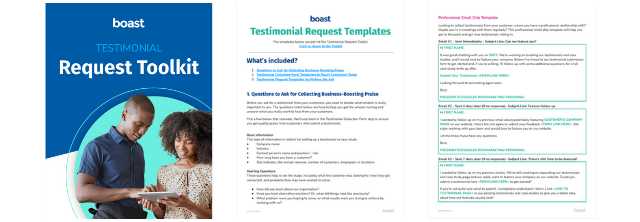The terms “testimonial” and “review” are sometimes used interchangeably, but there are important differences between them. Knowing the differences between a testimonial vs. review and what each can be used for will help you to use your customers’ sentiments effectively. We’ve updated this post in 2022 to give you even more information and help you nail your review and testimonial collections.
Testimonial vs Review: What’s the Difference?
| Review | Testimonial |
|
|
|
|
|
|
|
|
|
|
Why Does It Matter?
It’s clear that reviews and testimonials are similar, but not the same. So why does it matter?
We’ll cover this in more detail later in the post, but the differences between a testimonial vs review is important to understand so you know how to gather each one, and which one will be most useful for you.
Since testimonials are longer and a bit more personal, you may need to connect with customers a bit more personally, and consider questions prompts for your testimonial carefully. Since reviews are more effective in large quantities, it’s more important to ask your customers regularly and frequently. You’ll also want to target the right platform. Some third-party review platforms will be more effective than others, depending on your business and products or services.
What is a Testimonial?
The first biggest difference between a testimonial vs review is that the testimonial is more in-depth. In a testimonial, the customer explains their experience with your product or service, why they chose it, and how it improved their lives.
The second notable difference is where testimonials appear. Testimonials are generally given by the customer directly to the company. Reviews, on the other hand, are generally given to a third-party site. The business will usually ask the customer for their permission to use the testimonial in their promotional materials, such as a commercial, brochure, or on the business’s website.
Finally, the content between testimonials vs. reviews vary. Since a business usually asks a customer for a testimonial directly, testimonials are almost always positive. After all, a company wouldn’t ask an unhappy customer and unhappy customers wouldn’t provide a testimonial anyway.
Featured Resource: Testimonial Request Email Templates
Download the Testimonial Request Toolkit
What is a Review?
Reviews differ from testimonials in several important ways. To start, reviews are generally shorter than testimonials. Customer reviews will generally describe a particular interaction or a general overview of the customer’s feelings towards the company. The review may be a word or two, one or two sentences, or a short paragraph.
Since they are shorter, the quantity of good reviews is generally more important than how detailed they are. While customer testimonials are almost always positive, since they’re given by customers directly to the company, customer reviews can be positive or negative.
Customers may provide reviews to third-party websites, such as Google, Facebook, Yelp, Trip Advisor, or other sites. Since these reviews are technically the intellectual property of the review site and the customer, it’s difficult for businesses to reuse these on their website or promotional materials.
How to Use Testimonials
The best ways to use testimonials vs reviews varies. Testimonials are longer and provide more detailed information about your business, and what your customers could expect. This is ideal for potential customers who are considering buying from or working with you, but aren’t convinced yet. Consider where these customers might look for information about you, and how you can present this information in the best way. One or more of the following might be great places to put your testimonials.
- Your website: place your testimonials on a dedicated testimonials webpage, on your products page, landing pages, portfolio page, or anywhere your potential customers might need a bit more explanation or convincing.
- Product brochures: Use your written testimonials or transcribe some snippets from your testimonial videos to show what customers think about your products.
- Television commercials: Potential customers will believe other customers before they’ll believe a business owner, employee, or actor. Turn your video testimonials into television commercials to reach a wider audience with a convincing message.
- Online video advertisements: 73% of American adults use YouTube, making it the most popular online platform in the country. It’s also easier and more affordable to post an advertisement on YouTube than television. Use your video testimonials here, or use them in other online advertisements.
- In emails: You might be using a series of emails to encourage customers to make a purchase, or to purchase again. Add text from your testimonials or a link to your testimonial videos to let your customers do the talking for you.
Featured Resource: Testimonial Request Email Templates
Download the Testimonial Request Toolkit
How to Use Reviews
Customers have final say in where they post reviews, but you can encourage them to leave reviews in the best possible places. The best place for your happy customer to leave reviews is where the maximum number of customers will see your business. This will depend largely on what type of business you operate. Consider these possible review sites, and ask customers to leave reviews on the one that works best for you.
- Google: if a customer searches “best places for dinner,” “dentists near me,” “where to buy a bicycle,” or a similar search, their first stop is most likely Google. Your Google reviews and your Google My Business listing will be the first thing they see. Since it’s the first stop for billions of people around the world, it’s no surprise that this is the most popular review platform.
- Amazon: Before buying an item, customers want to know how well it works. If you sell products on Amazon, leave a note or send an email asking your customer to review it. Be wary of businesses using or selling fake reviews on Amazon, as it could land you in legal hot water.
- Facebook: Facebook has become a popular review platform mostly due to its massive user base. 1.56 billion people use Facebook on a daily basis, so it makes sense that they’d look here for reviews. If you’re also an active Facebook user, encourage customers to leave reviews on your business account.
- Yelp: This review site uses slightly different rules than the previous sites. Yelp explicitly states that “businesses should not ask for Yelp reviews.” The rules don’t get much clearer than this, but you can mention to your customers that you have a Yelp profile, or make a general invitation such as “check us out on Yelp.”
How to Get Testimonials
The right approach to get testimonials will depend a bit on your business, industry, and what type of testimonials you’re looking for.
Since testimonials tend to be longer and more detailed than reviews, you’ll want to consider which customers are ideal for testimonials, and reach out to them directly. Consider whether you’re looking for a text testimonial or a case study, or a video testimonial. What purpose do you want your testimonial to fulfill?
Most likely, you’re looking for a testimonial that will show other prospective customers that people similar to them enjoy your business. You may also want to address any fears or doubts that prospective customers might have.
- Select the customers that are ideal for a testimonial
- Reach out to them. Remember, your customers are busy people and you’ll probably have to reach out more than once.
- Collect some question prompts, so your customers know what you’re looking for and what they should address or mention.
- Create an easy process for customers to submit their testimonials.
- Set up an area to display your testimonials, either online, in print, another location, or multiple locations.
How to Get Reviews
Reviews are most effective in larger numbers. Usually, customers submit reviews to third-party sites, but this isn’t always the case. In some cases, you might ask for reviews directly, so you can post them on your website, perhaps on a products or services page.
To get reviews, there are a few considerations to address first. Just like gathering testimonials, you should first consider what you want your reviews to accomplish. Most likely, you want your reviews to bring in customers when they search for your business online. But, they might be searching in different places. You’ll want to prioritize which review sites are best for your business first.
For example, a business providing a professional service like an attorney’s office, doctor, or dentist, might want to prioritize reviews on websites aimed at professional services. Restaurants, coffee shops, and similar businesses might want to prioritize Google reviews, since customers often start their search for these types of businesses there. Which review site is best—or perhaps you want to gather reviews yourself for your own website or marketing materials—will depend on your business goals and web traffic trends.
It’s valuable to collect a lot of reviews, rather than a few detailed reviews. To save time, it makes sense to automate this process with email drips and an easy-to-use landing page. This way, you can collect reviews consistently.
When it comes to deciding between testimonials vs reviews, the best answer is to use both. Understand the differences between these, and how best to use them in your industry. With both types of praise, you can win new customers at every opportunity.
Posted in: Social Proof



